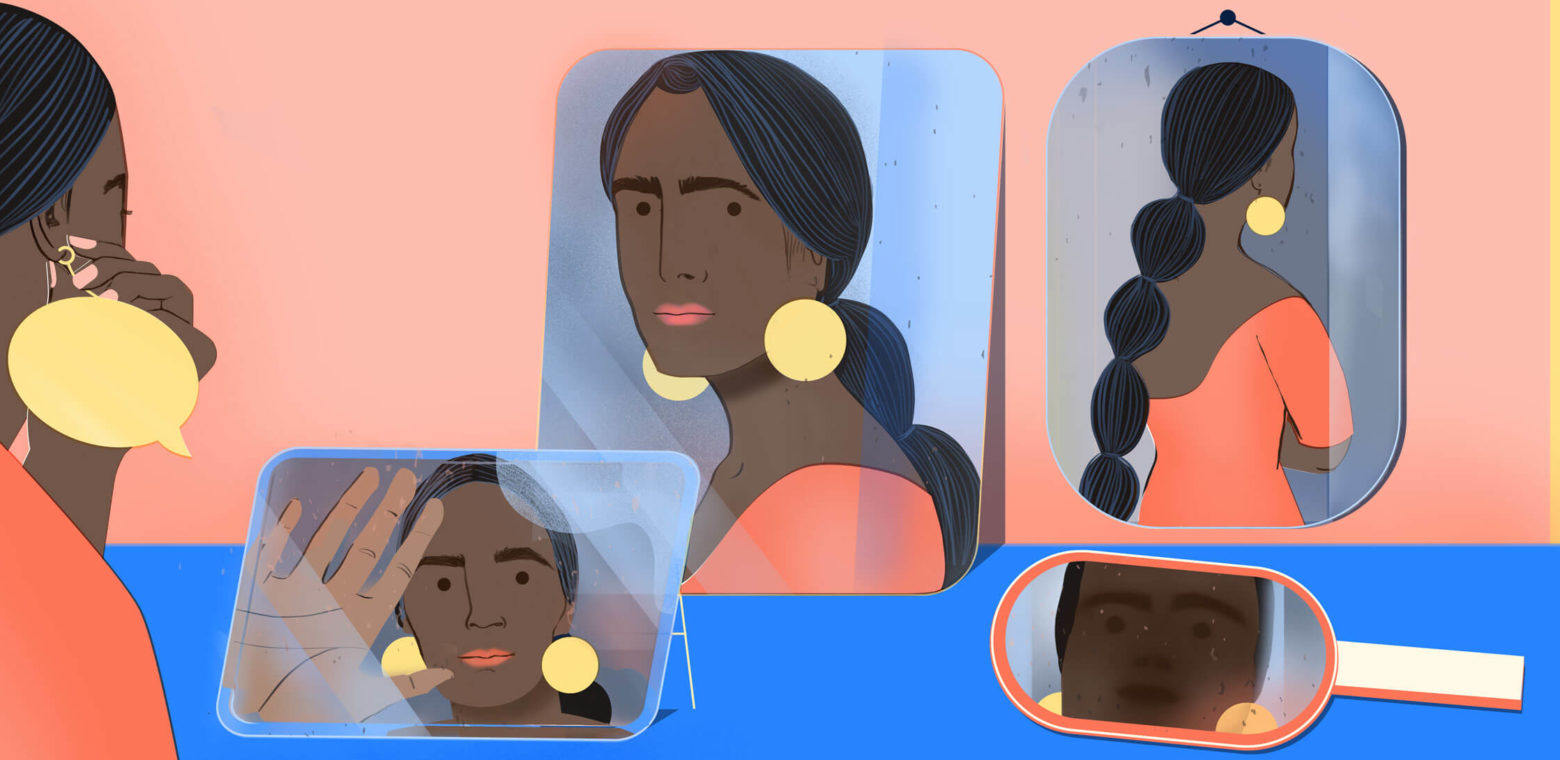The Johari window: a fresh take on self-reflection
Discover traits you may not see in yourself by asking your team to participate in this illuminating personality assessment.
5-second summary
- The Johari window is an exercise that can help you have a better understanding of yourself and how others see you.
- It helps you identify the qualities that both you and your colleagues agree you possess, as well as those that they see but you don’t, and those that you notice but they don’t.
- The descriptors you and your colleagues select are categorized into the Johari window’s four quadrants, which help you determine how to act on your takeaways.
Maybe you’ve never thought of yourself as particularly persuasive. But when your team has a big idea, you’re the one they elect to pitch it. Much to your surprise, they say you have a real knack for influencing people.
It’s a departure from your own perception – but the fact that you missed it is not surprising. While most of us like to think of ourselves as self-aware, one study found that only 10-15% of people actually fit the criteria.
The Johari window can help you and your teammates get a better grasp on your most prominent qualities – as well as the areas you can improve.
What is the Johari window?
The Johari window is an exercise that helps you gain a better understanding of yourself and how others see you. It was created by psychologists Joseph Luft and Harrington Ingham in 1955 as part of their work on group dynamics. Fun fact: “Johari” is a combination of their first names.
To use it, you’ll review a list of adjectives and choose five or six terms that best describe you. Then, you’ll have your colleagues do the same, choosing the descriptors they think fit you best. Then, you plot each list on a four-quadrant matrix.
The Johari matrix looks kind of like a window with four panes (hence the “Johari window” moniker), but some people refer to it as a “Johari house” with four rooms.
As you sort the adjectives into their appropriate quadrants, you uncover what qualities both you and your colleagues agree that you possess, which ones they see but you don’t, and which ones you notice but they don’t pick up on.
While the whole process might make you feel a little vulnerable (taking a magnifying glass to yourself can be tough!), the Johari window will help you:
- Understand how you’re perceived by the people you work with
- Build stronger relationships on a shared understanding and foundation
- Approach conversations and interactions with that helpful context
- Make improvements to address blind spots or negative qualities
- Learn to accept feedback, even if it’s hard to hear

What are the four Johari window quadrants?
Open area (also called the Arena):
Adjectives that were selected by both you and your team. Ideally, you’ll see lots of words here, which would indicate that you and your team are more or less aligned on what qualities best describe you.
Hidden area (also called the Facade):
Adjectives that were selected by you, but not your colleagues. Work to call more attention to these. For example, if you chose “listener” but your colleagues didn’t, you might focus on allowing more time and space for other people to chime in during meetings.
Blind spot:
Adjectives that were selected by your colleagues, but not by you. If there are terms here you don’t want associated with you, you can work to address your blind spots and demonstrate the characteristics you’d rather be associated with. For example, if your colleagues described you as “idealistic,” you might work to back up more of your decisions and suggestions with data and other evidence. But, if there are terms in the blind spot that you do want to be associated with that you don’t feel you currently possess, that can be great encouragement to you to continue growing in those areas.
Unknown (also called the Dark):
Adjectives that weren’t selected at all. If there are qualities here you’d like to exemplify, identify them and figure out how you can work toward them.
How does the Johari window work?
Want to give the Johari window a try on your own team? Follow these four steps.
1. Write a list of traits
You’ll need to start with a list of traits for you and your colleagues to pull from. Here’s a list of descriptors you can share with your team.
2. Choose words to describe yourself
Review the list and select five or six adjectives that you think best describe you. Keep them to yourself for now and focus specifically on qualities that you think you embody most in a work setting (rather than your personal life).
3. Have colleagues select traits that descibe you
Next, your colleagues get a chance to privately select an equal number of descriptors that they think most accurately characterize you. Depending on the size of your team, you could approach this one of two ways:
- Have your coworkers collaborate to decide on adjectives together. They’ll have to achieve a consensus, but it’ll give you fewer data points to wade through and categorize.
- Have each of your coworkers select adjectives individually. It may result in a large list, but will also give you a more detailed picture of how you’re perceived.
4. Sort traits into the correct quadrants
Now that you and your coworkers have your selected adjectives ready to go, it’s time for the big reveal. Draw the Johari window on a surface that’s visible to all of you, whether it’s a real whiteboard or a virtual one.
Next, review your list of adjectives alongside the descriptors that your colleagues selected. Start by looking for the ones that overlap and jot those down in the open area. Next, put the ones that your coworkers chose but you didn’t in your blind spot…and so forth. Keep working your way through all the adjectives.
Once your descriptors are categorized appropriately, you can start a candid discussion about why certain traits landed where they did. Repeat the exercise with each teammate so everyone can benefit from insight into how they present themselves at work.
Johari window examples
Let’s take a look at a few examples, using some beloved fictional characters, to get a feel for what this exercise looks like in practice.
James Bond
007 is known for his charm, cunning, and risky behavior. Here’s what his Johari window might end up looking like:
| Open Area Innovative Observant | Blind Spot Bold Impulsive Risk taker |
| Hidden Area Adventurous Confident Clever | Unknown …all other adjectives from the master list |
Potential takeaway: James is surprised to hear that he’s coming off as impulsive to his team at MI6. He puts a lot of thought and strategy into the decisions he makes, but apparently that isn’t obvious to his colleagues. Moving forward, he’ll try to give more visibility into his decision-making processes so his teammates don’t think he’s always flying by the seat of his pants.
Leslie Knope
She’s the unstoppable force that drives the Pawnee Department of Parks and Recreation – and she’s notorious for her relentless energy and can-do attitude. Here’s what her Johari window might end up looking like:
| Open Area Energetic Helpful Organized | Blind Spot Dominant Intelligent |
| Hidden Area Confident Loyal | Unknown …all other adjectives from the master list |
Potential takeaway: Leslie knew she was passionate and strong-willed, but she had no idea that might be translating as domineering to her colleagues. She’s going to be more mindful about hearing other people’s opinions and giving them a chance to speak.
Michael Scott
To be fair, the simultaneously self-important-yet-lovable Regional Manager of Dunder Mifflin would probably apply every single positive adjective to himself. But if he could put his lack of modesty aside, here’s what his Johari window could look like:
| Open Area Energetic Silly Tenacious | Blind Spot Idealistic Impulsive |
| Hidden Area Ingenious Powerful | Unknown …all other adjectives from the master list |
Potential takeaway: Michael is shocked to hear that is ingenuity isn’t coming through to the rest of his team. He’s going to use this opportunity to be more vocal about all the “golden ticket” ideas he has up his sleeve.
Look through the window and learn about yourself
Even if your team members know each other well, the Johari window will likely reveal a few surprises.
The information you discover won’t just be personally enlightening – it will help you make improvements and ultimately connect with your coworkers on a deeper level.
Plus, you’re the perfect candidate to get your team members on board with this bonding activity. You’re the persuasive one, after all.












































